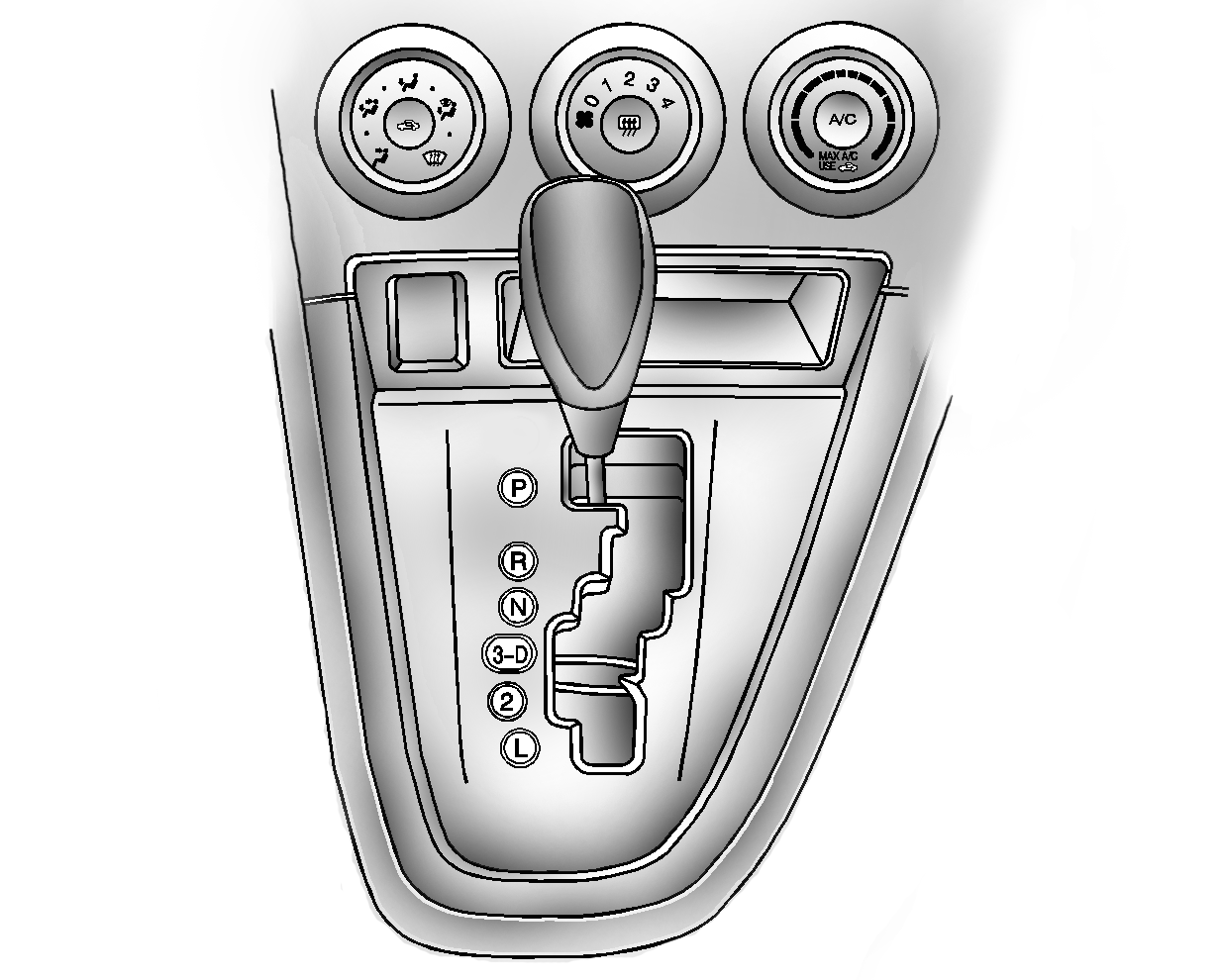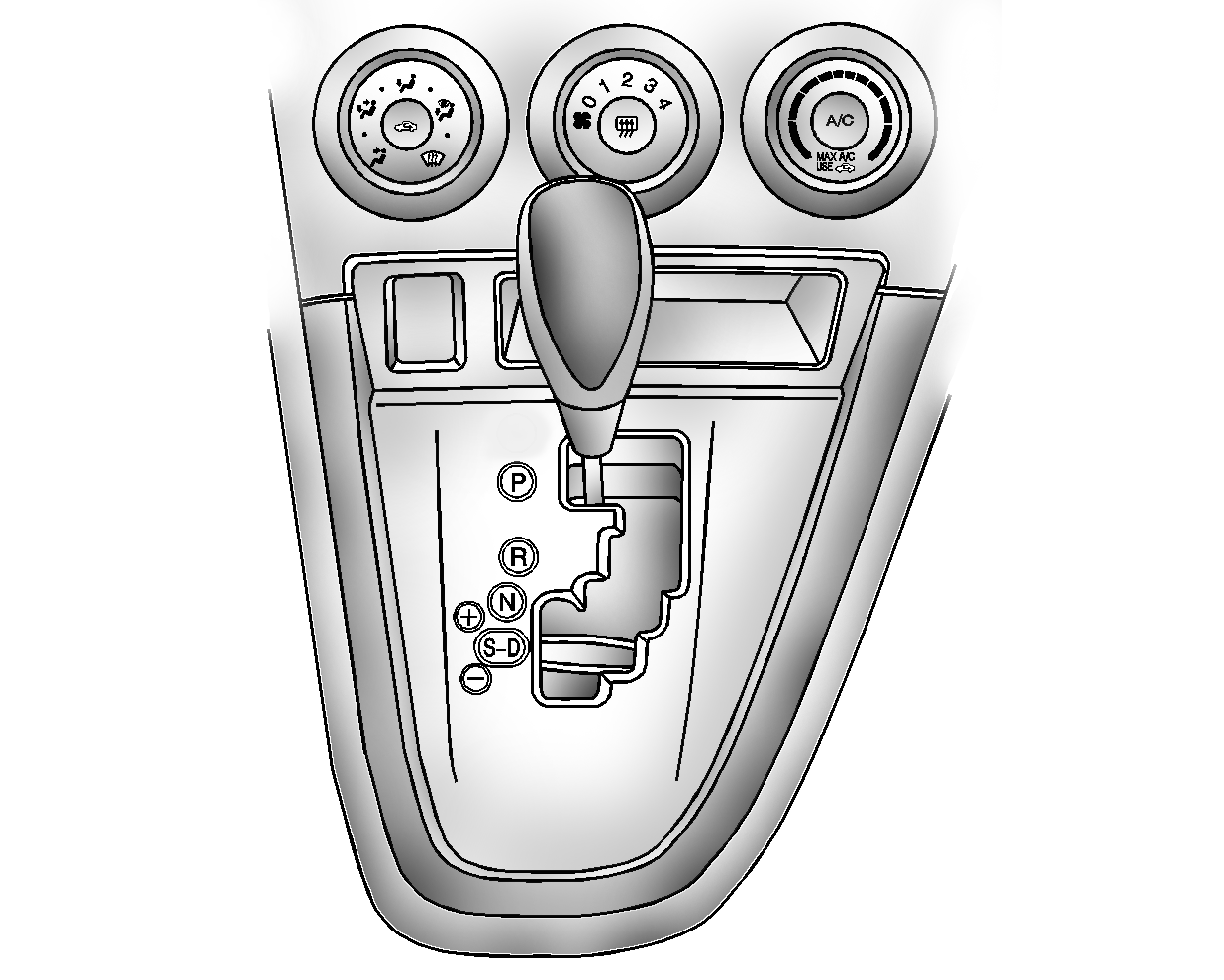Automatic Transmission Operation Four Speed

The shift lever is located on the console between the seats.
P (Park): This position locks the front wheels. It is the best position to use when you start the engine because the vehicle cannot move easily.Caution: It is dangerous to get out of the vehicle if the shift lever is not fully in P (Park) with the parking brake firmly set. The vehicle can roll.
Do not leave the vehicle when the engine is running unless you have to. If you have left the engine running, the vehicle can move suddenly. You or others could be injured. To be sure the vehicle will not move, even when you are on fairly level ground, always set the parking brake and move the shift lever to P (Park). See Shifting Into Park . If you are pulling a trailer, see Towing a Trailer .Make sure the shift lever is fully in P (Park) before starting the engine. The vehicle has an automatic transmission shift lock control system. You must fully apply the regular brake first and move the shift lever to the right before you can shift from P (Park) when the ignition key is in ON/RUN. If you cannot shift out of P (Park), ease pressure on the shift lever, then push the shift lever all the way into P (Park) as you maintain brake application. Then move the shift lever to the right and move the shift lever into another gear. See Shifting Out of Park .
R (Reverse): Use this gear to back up.Notice: Shifting to R (Reverse) while the vehicle is moving forward could damage the transmission. The repairs would not be covered by the vehicle warranty. Shift to R (Reverse) only after the vehicle is stopped.
To rock the vehicle back and forth to get out of snow, ice or sand without damaging the transmission, see If Your Vehicle is Stuck in Sand, Mud, Ice, or Snow .
N (Neutral): In this position, the engine does not connect with the wheels. To restart the vehicle when it is already moving, use N (Neutral) only. Also, use N (Neutral) when the vehicle is being towed.Caution: Shifting into a drive gear while the engine is running at high speed is dangerous. Unless your foot is firmly on the brake pedal, the vehicle could move very rapidly. You could lose control and hit people or objects. Do not shift into a drive gear while the engine is running at high speed.
Notice: Shifting out of P (Park) or N (Neutral) with the engine running at high speed may damage the transmission. The repairs would not be covered by the vehicle warranty. Be sure the engine is not running at high speed when shifting the vehicle.
D (Drive): This position is for normal driving. It provides the best fuel economy. If you need more power for passing, and you are:| • | Going less than 35 mph (56 km/h), push the accelerator pedal about halfway down. |
| • | Going about 35 mph (56 km/h) or more, push the accelerator all the way down. |
Notice: If the vehicle seems to start up rather slowly or not shift gears when you go faster, and you continue to drive the vehicle that way, you could damage the transmission. Have the vehicle serviced right away. You can drive in L2 (Low) when you are driving less than 35 mph (56 km/h) and D (Drive) for higher speeds until then.
2 (Second): This position reduces vehicle speed more than D (Drive) without using the brakes. You can use 2 (Second) on hills. It can help control vehicle speed as you go down steep mountain roads, but then you would also want to use the brakes off and on.L (Low): This position reduces vehicle speed even more than 2 (Second) without using the brakes. You can use it on very steep hills, or in deep snow or mud. If the shift lever is put in L (Low), the transmission will not shift into low gear until the vehicle is going slow enough.
Automatic Transmission Operation Five Speed

The shift lever is located on the console between the seats.
P (Park): This position locks the front wheels. It is the best position to use when starting the engine because the vehicle cannot move easily.Caution: It is dangerous to get out of the vehicle if the shift lever is not fully in P (Park) with the parking brake firmly set. The vehicle can roll.
Do not leave the vehicle when the engine is running unless you have to. If you have left the engine running, the vehicle can move suddenly. You or others could be injured. To be sure the vehicle will not move, even when you are on fairly level ground, always set the parking brake and move the shift lever to P (Park). See Shifting Into Park . If you are pulling a trailer, see Towing a Trailer .Make sure the shift lever is fully in P (Park) before starting the engine. The vehicle has an automatic transmission shift lock control system. You must fully apply the regular brake first and move the shift lever to the right before shifting from P (Park) while the ignition key is in ON/RUN. If you cannot shift out of P (Park), ease pressure on the shift lever and push the shift lever all the way into P (Park) as you maintain brake application. Then move the shift lever into another gear. See Shifting Out of Park .
R (Reverse): Use this gear to back up.Notice: Shifting to R (Reverse) while the vehicle is moving forward could damage the transmission. The repairs would not be covered by the vehicle warranty. Shift to R (Reverse) only after the vehicle is stopped.
To rock your vehicle back and forth to get out of snow, ice, or sand without damaging the transmission, see If Your Vehicle is Stuck in Sand, Mud, Ice, or Snow .
N (Neutral): In this position, the engine does not connect with the wheels. To restart the engine when the vehicle is already moving, use N (Neutral) only. Also, use N (Neutral) when the vehicle is being towed.Caution: Shifting into a drive gear while the engine is running at high speed is dangerous. Unless your foot is firmly on the brake pedal, the vehicle could move very rapidly. You could lose control and hit people or objects. Do not shift into a drive gear while the engine is running at high speed.
Notice: Shifting out of P (Park) or N (Neutral) with the engine running at high speed may damage the transmission. The repairs would not be covered by the vehicle warranty. Be sure the engine is not running at high speed when shifting the vehicle.
D (Drive): This position is for normal driving. It provides the best fuel economy from the vehicle. If you need more power for passing, and you are:| • | Going less than 35 mph (55 km/h), push the accelerator pedal about halfway down. |
| • | Going about 35 mph (55 km/h) or more, push the accelerator all the way down. |
Driver Shift Control (DSC)
DSC mode allows you to choose the top gear limit of the vehicle's transmission and the vehicle's speed while driving down hill or towing a trailer. To use this feature, do the following:
- Move the shift lever from D (Drive) left to S (Shift Control).
- Move the shift lever forward to increase the gear range, or rearward to decrease the gear range available based upon your current driving conditions and needs.
While driving in this mode, the transmission will remain in the driver selected range. When coming to a stop, the vehicle will automatically shift into 1 (First) gear.
The number displayed in the instrument cluster is the highest gear that the transmission will be allowed to operate in. However, your vehicle can automatically shift to lower gears as required by various driving conditions. This means that all gears below that number are available.
The display in the instrument cluster will change from the currently displayed message to 4 (Fourth) when you enter S (Shift Control), and change to indicate the requested gear range when moving the shift lever forward or rearward.
While using the DSC feature the transmission will have firmer shifting and sportier performance. You can use this for sport driving or when climbing hills to stay in gear longer or to downshift for more power or engine braking.
The transmission will only allow shifting into gears appropriate for the vehicles speed and engine revolutions per minute (RPM):
| • | The transmission will not automatically shift to the next higher gear if the vehicle speed or engine RPM is too high. |
| • | The transmission will not allow shifting to the next lower gear if the vehicle speed or engine RPM is too high. An audible warning will sound and the downshift will not be allowed. The downshift request will have to be made again once the vehicle reaches an acceptable speed. |
Downshift Requested | Required Vehicle Speed |
|---|---|
4 (Fourth) to 3 (Third) | Below 95 mph (153 km/h) |
3 (Third) to 2 (Second) | Below 60 mph (97 km/h) |
2 (Second) to 1 (First) | Below 30 mph (48 km/h) |
